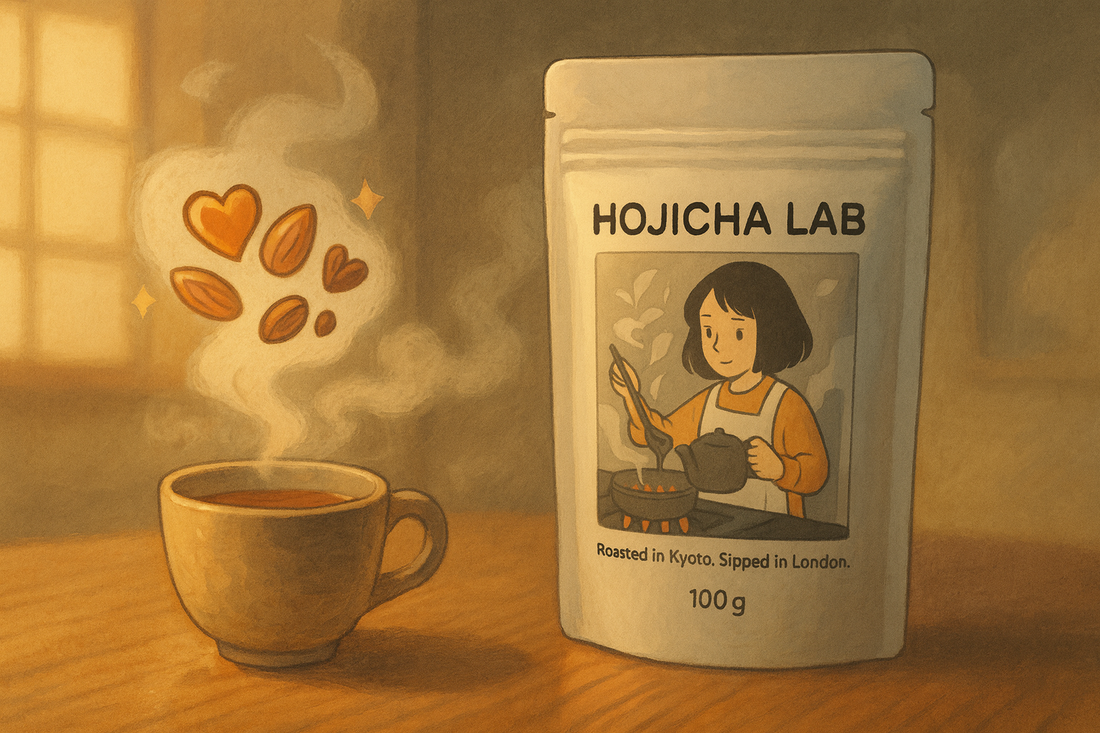
What Does Hojicha Taste Like? (Toasty, Caramel, Cosy)
Hojicha is a roasted Japanese green tea with a mellow, comforting profile.
Toasted nut Caramel Cocoa hints Gentle sweetness Low bitternessImagine the aroma of warm toasted nuts drifting from a bakery and the soft sweetness of caramelising sugars—that’s hojicha in a cup. Unlike grassy green teas, hojicha is roasted after steaming, transforming fresh, verdant tones into cosy, brown-sugar warmth with a whisper of cocoa and roasted cereal. The result is smooth, round and highly sippable morning, afternoon, or evening.
Why It Tastes Toasty (the roast chemistry)
Roasting triggers Maillard reactions—the same family of reactions that brown bread, coffee and roasted nuts. Heat drives off some of the green, grassy volatiles and gently reduces sharp catechins, which is why hojicha tends to taste less bitter than other green teas. Meanwhile, new flavour compounds develop, giving notes of hazelnut/almond, light caramel, cocoa nib and toasted barley. The mouthfeel becomes rounder, with a clean finish that doesn’t cling or astringe.
Hojicha flavour wheel (accessible)
A descriptive, text-based ‘flavour wheel’ without external assets.
Powder vs Loose Leaf Taste
Powder (for lattes & whisking)
Hojicha powder disperses the roast into every sip, giving a richer flavour intensity and a slightly creamier body—even in water alone. Expect pronounced cocoa, malt and toffee edges. Because you ingest the fine particles, the flavour is more concentrated and the colour deeper amber to mocha.
Loose Leaf (brewed)
Loose leaf hojicha (including stemmy kukicha styles) tastes lighter and cleaner with a more transparent roast: toasted grain, gentle caramel and a refreshing, tea-like finish. Stems often add a soft natural sweetness and cereal note reminiscent of roasted barley tea.
With Milk vs With Water
With milk (or oat/almond): dairy sugars and fats amplify caramel and toffee, rounding the roast into a dessert-like cup. You’ll notice cocoa and biscuit notes pop, especially with a dusting of powder on top. Oat milk accentuates biscuit and brown-sugar; almond leans into nutty marzipan; dairy gives café-latte silkiness.
With water: you’ll taste the tea’s structure more clearly—toasted cereal, light nut, chicory, barley—with a drier, brisker finish. Brew 90–95 °C for 1–2 minutes for a soft cup, or up to 3 minutes for deeper roast without harshness.
Iced vs Hot
Hot hojicha is the definition of cosy: aromatic, toasty and soothing, perfect for evenings thanks to naturally low caffeine. Iced hojicha is crisp and refreshing; the chill dials up cocoa-nib and roasted-barley while toning down any lingering astringency. For a cold brew, steep loose leaf in cold water for 4–6 hours in the fridge: you’ll get a clean, sweet roast with zero bitterness. For an iced latte, whisk powder with a splash of hot water to dissolve, then shake with cold milk and ice for a silky, caramel-leaning cooler.
Pairing Ideas
Breakfast
- Buttered toast with honey or marmalade (toffee meets citrus).
- Warm porridge with brown sugar and roasted sesame.
- Banana bread, cinnamon buns, or a flaky almond croissant.
Desserts & bakes
- Basque cheesecake or classic New York cheesecake (caramel synergy).
- Dark chocolate tarts, cocoa shortbread, tiramisu twists.
- Black sesame cookies or miso-caramel blondies for a salty-sweet echo.
If you dislike grassy teas, try this.
If “grassy” or “seaweed-y” isn’t your vibe, hojicha is the gentler green: roasting softens green notes into nutty, malty warmth. It’s the bridge between tea and coffee lovers—comforting like a light roast coffee, yet smooth and low in bitterness.
Taste the cosy roast
Brew it straight or whisk into a caramel-leaning latte in 30 seconds.
FAQ
- Is hojicha bitter?
- Not typically. Roasting mellows sharp catechins and reduces perceived bitterness, so hojicha drinks smooth and toasty with a clean finish.
- Does it taste smoky?
- Hojicha is roasted, not smoked. Expect toasted nut, cocoa and caramel rather than campfire smoke. Some high-roast styles can hint at light smokiness, but it’s subtle, not acrid.
- Is it sweet without sugar?
- It isn’t sugary, but many people perceive a gentle natural sweetness—think brown sugar or toffee edges—from Maillard reactions during roasting.